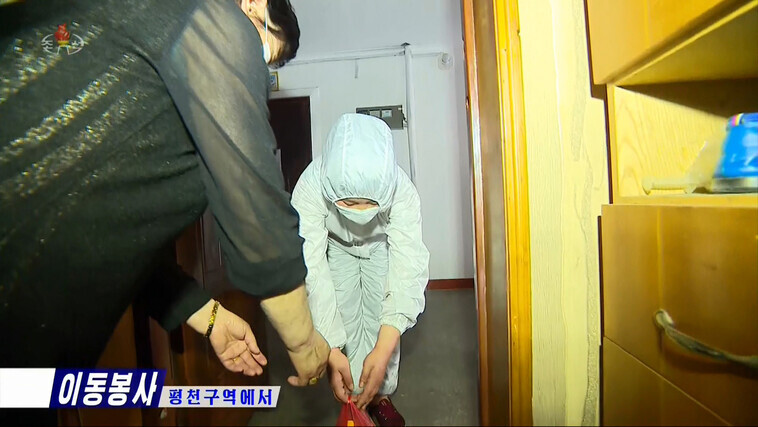hankyoreh
Links to other country sites 다른 나라 사이트 링크
N. Korean COVID-19 death toll likely exceeds 50,000, S. Korean expert says

As of Sunday, one month has passed since North Korea officially confirmed its first COVID-19 case on May 12. The media frenzy surrounding the COVID-19 situation in the country has subsided, while military tensions are escalating on the Korean Peninsula, with Pyongyang’s potential nuclear test being covered as major news.
Still, the question remains: Is North Korea really in control of the massive spread of COVID-19 within its borders as it has maintained, despite the fact that it saw 400,000 new cases of “fever” in a single day at one point and has neither vaccines nor protective equipment?
As of Friday, the cumulative total of individuals who have shown signs of fever according to North Korean authorities reached 4,349,900. According to Pyongyang’s Friday announcement, 4,215,850 among them have fully recovered while 134,050 are still in quarantine and receiving treatment. Daily caseloads have fallen to the 40,000 to 50,000 range.
But what’s especially noteworthy is North Korea’s COVID-19 death toll, which supposedly numbers 71. On May 14, immediately after confirming its firth COVID-19 case, North Korea announced that it saw 21 deaths caused by the virus. Five days later, on May 16, it confirmed eight more deaths and an additional six deaths each on May 17 and May 18. But from May 19 to June 4, the country only confirmed one to two deaths per day. Even more, no deaths have been announced since June 5.
If one took these figures at face value, the COVID-19 fatality rate in North Korea would be estimated at 0.002% despite the country’s inadequate medical infrastructure. This would be akin to a miracle, an accomplishment of disease control unmatched by any country in the world.
During a Sunday interview with the Hankyoreh, Shin Young-jeon, a professor at Hanyang University’s College of Medicine who is an expert on public health in North Korea, flatly stated that the official COVID-19 death toll of 71 announced by North Korean authorities is simply implausible, estimating that the actual figure would be closer to 50,000.
First, Shin projected that the actual cumulative caseload in North Korea would stand at 8 million at the very least, which is almost twice the number of individuals who have exhibited symptoms of fever according to North Korean authorities (4.34 million), as the official number is based on symptomatic cases. Shin’s estimation is based on the fact that 20% to 40% of COVID-19 cases are asymptomatic and the consideration that many patients may not have been found and added to the tally.
While the COVID-19 fatality rate varies by country, the figure for the Omicron variant is known to be about 0.6% for unvaccinated individuals and 0.07% for vaccinated individuals. If this ratio is applied to the 8 million estimated cumulative total COVID-19 cases in North Korea, it can be assumed that the virus probably caused roughly 50,000 (48,000) deaths in the country.

Shin speculated that most of these deaths would have been among older North Koreans and those with preexisting conditions who most likely died “silent deaths” that were not publicized.
Shin reasoned that the death toll of 71 announced by North Korean authorities “is probably based on deaths recorded among those who received PCR testing rather than an arbitrary number.” Pyongyang has stated that it has been carrying out roughly 120 PCR tests per day, and Shin thinks it’s likely that the official number of deaths reflects fatalities among those who received testing.
Shin said, “Even based on the announcement by North Korean authorities, those infected with COVID-19 amount to 16% of North Korea’s total population. The actual caseload is considered to be about 8 million, twice the official caseload on Friday, which accounts for 30% of the total population [in North Korea].”
“At that rate, it’s inevitable for the spread of COVID-19 to slow,” he added, explaining that this is why the daily caseload has dropped to the 40,000s recently in North Korea.
In terms of how the South Korean government should respond, Shin stressed that “humanitarian assistance without preconditions should be hastened, ranging from disease control supplies, diagnostic equipment, vaccines, and foodstuffs,” as the situation in North Korea is even more dire than during the “Arduous March” of the 1990s. Although North Korea may seem to be handling everything on its own despite adverse conditions, the country is currently besieged by the pandemic as well as a food shortage.
Shin continued, “President Yoon Suk-yeol should directly state that [South Korea] will assist [the North] without preconditions.” He added that “as inter-Korean public health cooperation including jointly responding to infectious diseases was already agreed upon by the South and North Korean leaders in 2018, there would be little justification for North Korea to reject [our assistance].”
“We should do our part by doing our best,” he said.
Shin also expressed the concern that “China may further hold the upper hand when it comes to North Korea” if things continue as is. Although experts question the efficacy of the Chinese COVID-19 vaccine, China has reportedly already supplied North Korea with its domestically produced vaccines.

Meanwhile, South Korean non-governmental organizations are seeking alternative ways to provide humanitarian assistance to North Korea from multiple angles, considering the food shortage in addition to the pandemic.
For one, the Korean Sharing Movement will be holding a seminar at Seoul Global Center on June 22 with major South Korean public health organizations such as the Korean Medical Association. At the seminar, Shin will present on the current status and development of the COVID-19 situation in North Korea as well as how to approach future cooperation, while Korean Sharing Movement Secretary General Hong Sang-young will shed light on how non-governmental assistance will be provided to the North.
Medical Aid for Children will also be holding a symposium for experts to come together to search for ways to respond to the COVID-19 situation in North Korea later this month.
Although he acknowledges that non-governmental organizations can play a meaningful role in assisting North Korea, Shin is skeptical that they will be able to provide urgently needed vaccines to the country on a large scale.
“The Yoon Suk-yeol administration and the president himself should take direct action from a humanitarian and national standpoint,” Shin repeatedly stressed. He added, “[The Yoon administration] should announce that [it] will supply vaccines, medical supplies, and medical equipment for 3 million people whenever and unconditionally so that healthcare professionals in North Korea can at least be vaccinated and respond [to the COVID-19 situation in the country].”
By Lee Chang-gon, senior staff writer and editorial writer
Please direct questions or comments to [english@hani.co.kr]

Editorial・opinion
![[Column] Season 2 of special prosecutor probe may be coming to Korea soon [Column] Season 2 of special prosecutor probe may be coming to Korea soon](https://flexible.img.hani.co.kr/flexible/normal/500/300/imgdb/original/2024/0426/3317141030699447.jpg) [Column] Season 2 of special prosecutor probe may be coming to Korea soon
[Column] Season 2 of special prosecutor probe may be coming to Korea soon![[Column] Park Geun-hye déjà vu in Yoon Suk-yeol [Column] Park Geun-hye déjà vu in Yoon Suk-yeol](https://flexible.img.hani.co.kr/flexible/normal/500/300/imgdb/original/2024/0424/651713945113788.jpg) [Column] Park Geun-hye déjà vu in Yoon Suk-yeol
[Column] Park Geun-hye déjà vu in Yoon Suk-yeol- [Editorial] New weight of N. Korea’s nuclear threats makes dialogue all the more urgent
- [Guest essay] The real reason Korea’s new right wants to dub Rhee a founding father
- [Column] ‘Choson’: Is it time we start referring to N. Korea in its own terms?
- [Editorial] Japan’s rewriting of history with Korea has gone too far
- [Column] The president’s questionable capacity for dialogue
- [Column] Are chaebol firms just pizza pies for families to divvy up as they please?
- [Column] Has Korea, too, crossed the Rubicon on China?
- [Correspondent’s column] In Japan’s alliance with US, echoes of its past alliances with UK
Most viewed articles
- 1[Column] Season 2 of special prosecutor probe may be coming to Korea soon
- 2‘We must say no’: Seoul defense chief on Korean, USFK involvement in hypothetical Taiwan crisis
- 3Is N. Korea threatening to test nukes in response to possible new US-led sanctions body?
- 4No good, very bad game for Korea puts it out of Olympics for first time since 1988
- 5Is Japan about to snatch control of Line messenger from Korea’s Naver?
- 6Division commander ordered troops to enter raging flood waters before Marine died, survivor says
- 7Korea’s 1.3% growth in Q1 signals ‘textbook’ return to growth, says government
- 8N. Korean delegation’s trip to Iran shows how Pyongyang is leveraging ties with Moscow
- 9[Editorial] Korea’s surprise Q1 growth requires objective assessment, not blind fanfare
- 10[Editorial] Government needs to stop impeding Sewol mourning